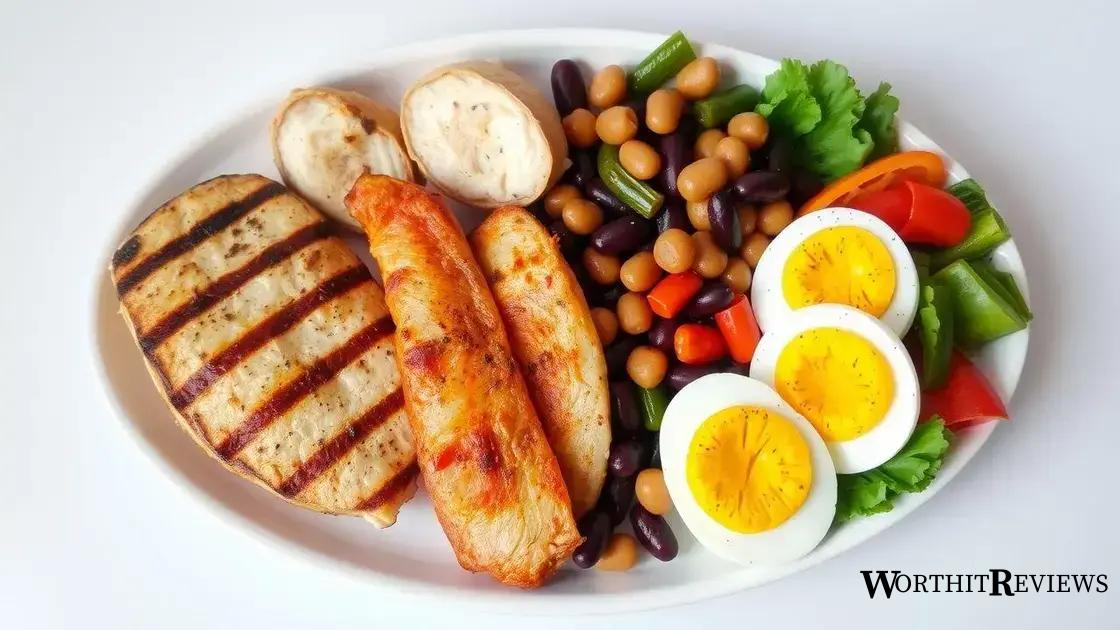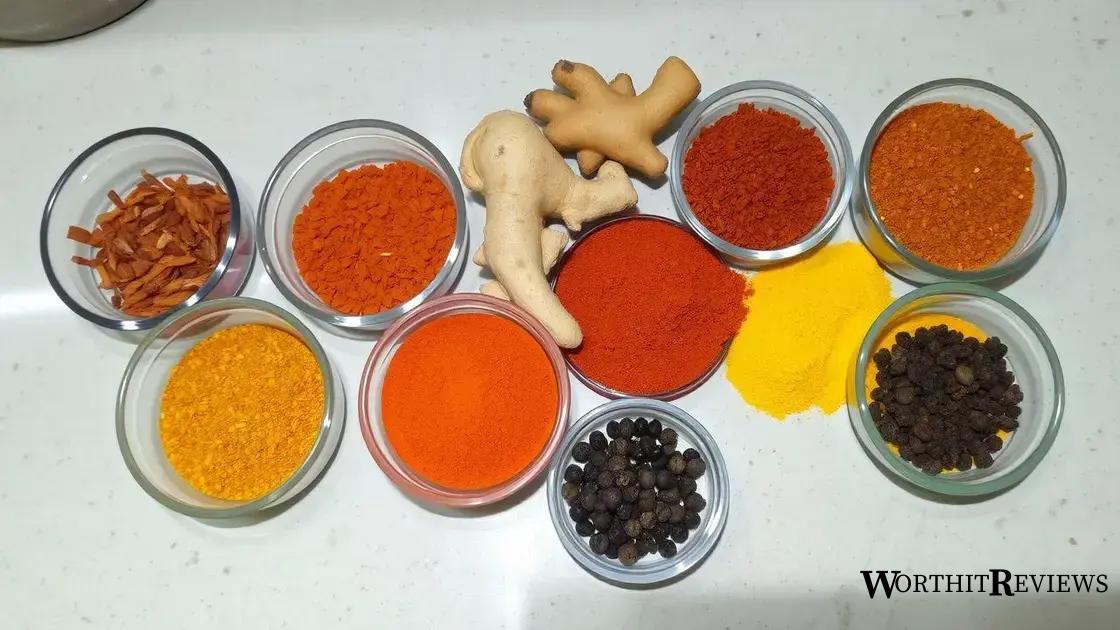Foods that help burn fat include lean proteins, fiber-rich vegetables, and metabolism-boosting spices, which improve satiety and enhance calorie burning when paired together effectively.
Foods that help burn fat can make a significant difference in your weight loss efforts. Curious about which items can speed up your metabolism while satisfying your cravings? Let’s dive in!
Top fat-burning foods to include in your diet
Including top fat-burning foods in your diet can make a difference in weight loss efforts. Many natural foods can help you achieve better results by boosting your metabolism.
Lean Proteins
Foods like chicken breast, turkey, and fish are excellent sources of lean protein that can increase feelings of fullness. Protein requires more energy to digest, contributing to a higher calorie burn.
Fruits and Vegetables
Citrus fruits such as oranges and grapefruits are not only refreshing but can also aid in fat burning. They are low in calories and high in water content, which can help keep you hydrated and satisfied. Leafy greens like spinach and kale are also important; they are low in calories and packed with nutrients.
Whole Grains
Incorporating whole grains like quinoa, brown rice, and oats is essential. Whole grains are filled with fiber that helps maintain a steady energy level and promotes digestive health.
Spices to Add
Don’t forget about spices! Adding cayenne pepper and cinnamon to your meals can provide a metabolism boost. These spices add flavor and can help increase calorie expenditure.
Nuts and Seeds
Almonds, walnuts, and chia seeds are good examples of healthy fats that can aid in fat loss. They help you feel full longer and provide important nutrients that your body needs.
How protein sources enhance fat loss

Protein sources play a crucial role in enhancing fat loss through several mechanisms. By incorporating quality proteins into your meals, you can boost your metabolism and promote satiety.
Increasing Satiety
Eating protein-rich foods can help you feel full longer. Lean meats, fish, eggs, and legumes can curb your hunger and reduce the temptation to snack on unhealthy options.
Boosting Metabolism
Protein has a higher thermic effect compared to fats and carbohydrates. This means your body burns more calories digesting and processing protein. Incorporating protein shakes or lean meats into your diet can enhance calorie burning.
Maintaining Muscle Mass
When losing weight, it’s essential to retain muscle mass. Consuming adequate protein helps prevent muscle loss while dieting. Foods like chicken, turkey, and tofu provide the necessary amino acids for muscle maintenance.
Balanced Meals
Building meals around protein can lead to balanced nutrition. Pairing sources like fish or beans with vegetables not only adds nutrients but can also create a satisfying plate that aids your weight loss journey.
Simple Protein Ideas
Consider incorporating simple protein ideas like Greek yogurt for breakfast, or snacking on nuts and seeds throughout the day. These options are an easy way to ensure you’re getting enough protein without significant effort.
The role of fiber in burning fat
Fiber is an essential component of a healthy diet that plays a significant role in burning fat. It aids digestion and supports various bodily functions that contribute to weight management.
Enhancing Digestion
Fiber helps improve digestion by adding bulk to your meals. Foods rich in fiber, such as fruits, vegetables, and whole grains, promote regular bowel movements. This helps your body eliminate waste efficiently, contributing to overall health.
Reducing Appetite
High-fiber foods can keep you feeling full longer. Incorporating sources like beans, lentils, and oats in your meals can control hunger and reduce the urge to snack on high-calorie foods.
Stabilizing Blood Sugar
Fiber helps slow down the absorption of sugar, leading to more stable blood sugar levels. This can prevent energy crashes and cravings, making it easier to stick to healthy eating habits.
Types of Fiber
There are two main types of fiber: soluble and insoluble. Soluble fiber, found in foods like apples and oats, can help lower cholesterol and blood glucose. Insoluble fiber, found in whole grains and vegetables, aids in digestion and prevents constipation.
Simple Ways to Add Fiber
Adding fiber to your diet can be simple. Start with whole grain bread or brown rice instead of white. Incorporate vegetables in every meal, snack on fruits, and try adding chia seeds or flaxseeds to smoothies.
Spices that boost metabolism for weight loss

Spices can be a powerful ally in your weight loss journey by naturally boosting metabolism. Incorporating certain spices into your meals can enhance flavor while aiding in fat burning.
Cayenne Pepper
Cayenne pepper contains capsaicin, a compound known for increasing metabolic rates. Adding cayenne to your dishes can help you burn more calories and enhance fat loss.
Cinnamon
Cinnamon is not just a sweet spice; it can also help regulate blood sugar levels and improve insulin sensitivity. Stable blood sugar can reduce cravings, making it easier to stick to your diet.
Ginger
Ginger can stimulate digestion and promote the feeling of fullness. Including ginger in your smoothies or as a tea can support your metabolism and keep hunger at bay.
Turmeric
Turmeric contains curcumin, which has anti-inflammatory properties that can aid in weight management. This spice can be easily added to rice dishes, soups, or smoothies.
Black Pepper
Black pepper contains piperine, which can enhance the absorption of other beneficial nutrients. Adding it to your meals may help improve metabolism and support weight loss.
How to combine foods for maximum effect
Knowing how to combine foods can maximize the benefits of your meals and enhance fat-burning potential. The right combinations can improve digestion and nutrient absorption.
Pairing Protein with Fiber
Combining proteins, like chicken or tofu, with fiber-rich foods such as broccoli or quinoa helps you feel full longer and stabilizes blood sugar levels. This combination enhances satiety and helps control cravings.
Healthy Fats for Flavor and Satisfaction
Incorporating healthy fats, such as avocado or olive oil, can optimize nutrient absorption, particularly for vitamins A, D, E, and K. Adding these fats to salads or whole grain dishes makes meals more satisfying.
Balancing Carbohydrates
Choosing whole grains over refined grains is important. Combining whole grains like brown rice or barley with colorful vegetables boosts the fiber content, which aids digestion and keeps you energized.
Creating Metabolism-Boosting Meals
Include spices that enhance metabolism, such as cayenne pepper or ginger, in your recipes. For example, a stir-fry with lean protein, whole grains, and a variety of vegetables seasoned with spices can create a fantastic fat-burning meal.
Including Hydrating Foods
Don’t forget to add hydrating foods like cucumbers and watermelon. These foods increase water intake and help with digestion, making your meals refreshing and nutritious.
In summary, the power of food combinations
Combining the right foods can enhance fat burning and improve overall health. By mixing proteins, healthy fats, and fiber-rich carbohydrates, you can create meals that keep you full and satisfied.
Incorporating flavor enhancers like spices and hydrating foods can also make your meals enjoyable while supporting your weight loss goals. Remember, it’s not just about what you eat, but how you eat those foods together.
With these tips, you can optimize your diet and enjoy delicious meals that help achieve your wellness goals.
